![]()
![]()
![]()
Use LEFT and RIGHT arrow keys to navigate between flashcards;
Use UP and DOWN arrow keys to flip the card;
H to show hint;
A reads text to speech;
18 Cards in this Set
- Front
- Back
- 3rd side (hint)
|
Pre-splitting |
This techniques is sometimes used to reduce ground blasting in some critical cases. Pre-split in the rock minimizes or eliminates overbreak from the subsequent primary blast by forming a discontinuous zone and also produce a smooth-finish rock wall. The charge in presplitting blasting hole is detonatedfirstly, which is arranged on the design contour.Followed by the detonation, a crack will be formed along the design contour line.Then, under the shielding of this artificial crack, the blasting of the main excavation site will be carried out to ensure the preservation of the retained rock mass from damage. |
|
|
|
Smooth(contour) Blasting |
This techniques is widely used in controlling overbreak and to produce an excavation contour without fracturing or damaging the rock behind or adjacent to the blasted face. The rock mass at the main excavation site are detonatedfirstly, and then the charge in presplitting blasting hole is detonated, which isarranged on the design contour.The blasting layer will be blown apart to form asmooth excavation face. |
|
|
|
Quality control standard of pre splitting |
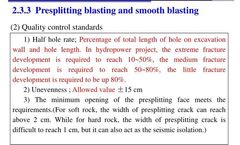
|
|
|
|
Parameters design of pre splitting |
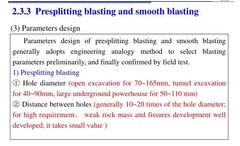
|
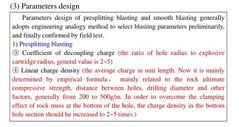
|
|
|
Parameters design of smooth splitting |
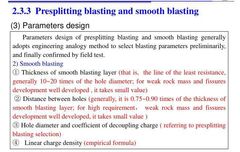
|
|
|
|
Empirical data for smooth and pre splitting |
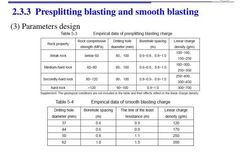
|
|
|
|
Characteristics of Foundation excavation of hydraulic structures |
1) The construction scope is limited, and it is easy to be affected by the diversion program during construction period 2) And with the concrete pouring, foundation grouting treatment and other processes in parallel operations; |
|
|
|
Principles of Foundation excavation of hydraulic structures |
* Top-down stratification excavation, * Deep-hole bench blasting |
|
|
|
Prevention of integrity of the foundation of the hydraulic structure |
A protective layer should be reserved in a certain range above the foundation plane. |
|
|
|
control the influence of blasting on the high rock slope, |
* presplitting blasting, * smooth blasting, * buffer blasting* deep-hole micro second* bench blasting |
|
|
|
Damming by directional throwing blasting |
Damming by directional throwing blasting is a dam construction technology that making use of the steep slope to arrange explosives,loosing collapse or throwing rock in the certain direction to the predetermined location, then manually repairing the dam to meet the design In terrain, the valley is narrow with the steep slopes (usuallyabove 40°°), and the height of the mountain should be more thantwice the design height of the damrequirements. |
|
|
|
Application conditions of Damming by directional throwing blasting |
In terrain, the valley is narrow with the steep slopes (usuallyabove 40°°), and the height of the mountain should be more thantwice the design height of the dam Applicable conditions: 2) In geology, the rock mass of the burst area should be equippedwith the following properties: homogeneous lithology, high strength,weak weathering, simple structure, thin cover, low groundwaterlevel and low seepage
.3) The anti-seepage inclined wall is often adopted for the dam which needs the strict anti-seepage requirements. 4) The import and export of the discharge structures and diversionbuildings should be outside the buildup range and meet the safetyrequirements to prevent the impact of blasting vibration.
|
|
|
|
Rock plug blasting |
Rock plug blasting is an underwater controlled blasting method which is economical and effective when taking water, generating power , irrigating, supplying water and discharging flood in the reservoirs or natural lakes,for the construction of tunnel intake and avoiding constructing the cofferdam in deep water |
|
|
|
Demolition blasting principle: |
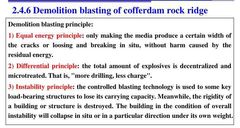
|
|
|
|
Classification of demolition blasting of cofferdam |
1. Slag blasting Slag blasting is the blasting method that uses the power of flow to flush the slag into the downstream river, and it is generally used for the blasting of the diversion tunnel outlet cofferdam and the downstream cofferdam of the foundation pit. 2. Residue blasting Residue blasting is the blasting method that uses machine to clean underwater residue after the cofferdam blasting. It isgenerally used for the removal of upstream cofferdam. |
|
|
|
Negative effect of blasting |
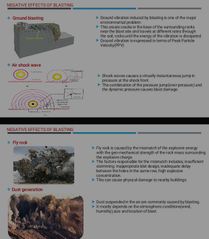
a. Blast wave in air.When the explosive air shock wave reaches a certain value, it will cause damage to the buildings and damage to the humanorgans.1) For humans, the overpressure of the wave front should be lessthan 1.96 ×104Pa;2) For buildings, RF=KBQ1/3 b. Explosive shock wave in water. When underwater blasting is done, it will also causes shock wave in water.Therefore, it is necessary to determine the minimum safe distance according to the relevant regulationsfor the person in water, ships and other protection object Explosion will produce various harmful gases, whose contentexceeding a certain amount can endanger the personal safety.The safedistance can be calculated as follows:RF=160(1+0.5VB) Q1/3 |
|
|
|
Control of blasting effects |
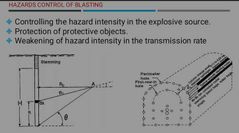
|
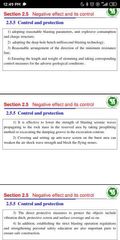
|
|
|
Blasting vibration |
A large part of the explosion energy that's transmitted to the surrounding area in the form of seismic waves, leading to the ground vibration during the rock blasting, |
|

